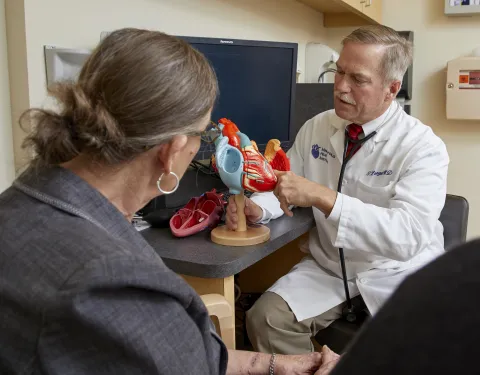- Our Research
- Education
- Giving
- News & Events
- About Us
- Donate
May 2, 2024
Image

Most people don’t think about their heart valves until they have a problem. The Minneapolis Heart Institute Foundation (MHIF) notes, “Many people who have heart valve disease are not aware of it, either because they have no symptoms or because they assume the lack of energy they experience is just part of aging.”
The issues known collectively as “heart valve disease” actually represent a large subset of conditions affecting the human heart.
Valve disease can lead to heart attacks, arrhythmias, and other heart conditions. If diseased heart valves are left untreated, heart failure can occur: the heart cannot pump enough blood and oxygen to support other organs in the body. Currently, nearly 6.5 million Americans over the age of 20 experience heart failure, and about 2.5% of the U.S. population has valve disease.
More malignant than breast cancer or prostate cancer, heart valve disease can negatively affect quality of life, leading eventually to death if not treated.
MHIF’s Valve Science Center – an international leader in heart valve disease research and treatment, based at the Minneapolis Heart Institute Foundation – has developed and advanced technologies to repair or replace diseased heart valves: aortic, mitral, pulmonary, and tricuspid. As time passes, treatments are becoming less invasive and can be accomplished even without surgery.
The Valve Science Center brings together the expertise of a diverse group of medical scientists, including interventional cardiologists, advanced imaging specialists, specialty nurses, research scholars, and cardiac surgeons. This interdisciplinary approach considers heart valve problems from multiple perspectives to arrive at the best possible solution for each patient.
It’s sobering to consider the 100,000 beats per day and 35 million beats per year of the average human heart. Those lucky enough to live to or past 80 will have stayed alive thanks in part to the 2.3 billion lifelong beats of their heart muscles.
Those beats represent potential wear and tear on the four small valves that keep well over a gallon of blood flowing in the right direction throughout the body.
Heart valve damage can result from heart attack and other medical conditions, or from common treatments for cancer such as radiation and chemotherapy. Although about two of every 100 people are born with a faulty heart valve, heart valve disease typically presents in people as they age.
Over time, valves can stiffen or become calcified in a process called stenosis. Or they can become stretchy and close improperly, causing blood to flow backwards; this is called a leaky valve or regurgitation. Either condition can cause the heart to work harder than it should.
It’s time we think more about our hearts – and the valves that keep our blood moving. If you have concerns, ask your health care provider about your risk for heart disease. Read more about heart valve disease on MHIF’s website, or attend one of our many community health events, where you can discover simple steps to care for your heart. Watch our recent On the Pulse event about valve and heart failure.
And if you learn that one of your valves is not working properly, you can take heart knowing that valve disease is eminently treatable.

